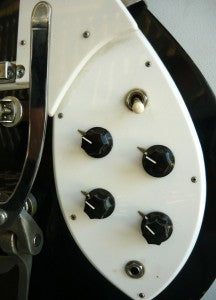1960's Guyatone SG42T
Share
Even before I got myself a copy of the great "Bizarre guitars" book years ago I'd been on the search for guitars like this. Even though the whole book is in Japanese it is a Bible for guitar nerds like me. Many nights I sat there and just looked at the pictures of these amazing and crazy Japanese guitars and wondered how I would ever see such beauties in real life.


This is one that I searched for as I'm a huge Rickenbacker fan and a Guyatone fan. I have several different versions of their Mosrite copies and I had to have one of these as well.
These are fairly rare but I have seen a few come up for sale over the years and there was also one available that had P-90 style pick ups which I prefer, not for sound, but for looks. These guitars are all about "the look". Not that most of them don't sound great or at the very least unique. Some of them, like these sound amazing.
The neck is typically thin like a lot of these "intermediate level" Japanese guitars from the mid to late sixties. The fretboard inlays mimic the triangle inlays from vintage Rics and influenced one of my guitars I made called a Tymenbacker. In fact this whole guitar was an influence on my guitar building. Sometimes these sixties Japanese guitars have great ideas apart from their shapes.

One of the things I love about this guitar is the neck joint. Rics have a neck joint that runs in through the body almost back to the bridge and is glued in. This gives them their last fret free of the body look while still being very stable.
This guitar uses a similar idea but with a great twist unlike any other guitar I've ever seen. It has a "tongue" like a Mosrite but screws to the TOP of the guitar instead of the back. Amazing.
The overall construction of this whole guitar is high quality which is seen right through. The finish of all the binding and construction is, as most of these guitars are, much better than current budget production guitars that these guitars are always compared to.


This is a very stable joint and still gives the impression of the neck hanging out of the body but with all the tension of the face of the guitar and not the back.
The guitar has a substantial neck block that this bolts into and runs along the top of the guitar thinning out as it gets back to the bridge pick up giving it a very "hollow body" tone. The fully floating bridge helps this tone also.
The pick ups are fairly high output but still with plenty of sparkle and clarity. Most of these type of guitars had ceramic magnet, plastic bobbin, simple construction pick ups with great frequency response. It's just another one of the great things about these guitars.
The best way to describe the sound and the way it plays is .............. Like a Ric but different.
It has the real Ric jangle and has a great low action and straight neck. There are some construction techniques here that make this different to a Ric and add to the uniqueness of this great guitar. Lots of these Japanese guitars have these great little idiosyncrasies that to me, just add to the appeal. Over the years I've owned quite a few of these types of guitars and my series of late sixties Teiscos have the very same appeal giving them those great unique tones and fantastic looks.
This guitar here is almost completely original except for the vibrato arm and the knobs which are almost identicle to the originals. The electrics, tuners and pick ups etc are all original and in full working order. The "Bigsby" vibrato is the same unit used by Greco (Ibanez) at the time.
While this is one of my favorites I've decided it's too nice to sit in a cupboard and deserves to be used so, it'll be for sale on my site very soon. It would be nice to walk into a venue and see someone using it for what it was made for.














